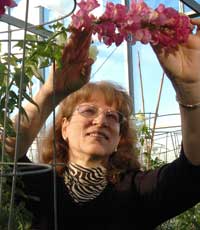West Lafayette, Indiana
January 19, 2005
Just one cellular pathway produces
the raw ingredients plants use to make thousands of compounds,
from molecules with anticancer properties to the active
ingredient in catnip, according to a team of researchers at
Purdue University and the
Max Planck Institute for
Chemical Ecology.
 This
finding challenges long-held assumptions about how plants
produce these commercially important products. The research also
could have important implications for researchers trying to
harness plant pathways to produce essential oils, often used as
flavor additives in food and medicine or as fragrance in
body-care products, said Natalia Dudareva (photo), professor of
horticulture and lead researcher of the study. This
finding challenges long-held assumptions about how plants
produce these commercially important products. The research also
could have important implications for researchers trying to
harness plant pathways to produce essential oils, often used as
flavor additives in food and medicine or as fragrance in
body-care products, said Natalia Dudareva (photo), professor of
horticulture and lead researcher of the study.
"Our research has applications in the future metabolic
engineering of essential oil production," Dudareva said. "The
yield of these compounds depends on the amount of materials
available in the cell, and knowing where these compounds come
from and which pathway produces them is the place to start."
Dudareva and her colleagues report in the current issue
(Tuesday, Jan. 18) of Proceedings
of the National Academy of Science that the molecular
precursors to a group of compounds called terpenoids - the
largest and most diverse family of natural products - come from
a single plant pathway, located inside the same part of a cell
where photosynthesis occurs.
Terpenoids are made from compounds called precursor molecules,
which are a kind of molecular raw material. Just as a potter can
transform five identical spheres of clay into five unique pieces
of art, identical precursor molecules can transform into unique
compounds by following different molecular pathways.
Scientists previously discovered that two independent pathways,
located in different compartments within a plant cell, use these
precursor molecules to produce terpenoids. Most scientists
assumed that both pathways were capable of producing these
precursor molecules as well.
The discovery that only one pathway produces these precursors is
a significant breakthrough, Dudareva said.
"We never expected to find this," she said. "This is the first
time anyone has realized that only one of the two available
pathways operates to make the precursor."
She also found that while some of the precursor molecules remain
in the compartment where they are made, some travel through the
cell to another compartment, where they enter a second pathway
in terpenoid production.
The process can be likened to a manufacturing plant with an
assembly line that makes a car part, such as a steering wheel.
Some of those steering wheels remain on-site to be added to cars
manufactured at that plant. Additional steering wheels are
transported to another plant that, instead of making its own
steering wheels, uses those from the first plant to produce its
product.
Just as delivering steering wheels from one manufacturing
facility to another requires some kind of transportation,
molecules also rely on vehicles to travel around the interior of
a cell. Exactly how the precursor molecules in this system
travel from one compartment to another, however, remains a
mystery.
"This work hints at the existence of a transporter to carry
precursor molecules across the cell," said David Rhodes, Purdue
professor of horticulture and a collaborator on the paper. "We
already know that plants have a huge number of compartments that
exchange materials. Now we need to figure out how these
compartments facilitate this one-way flow of precursor
molecule."
Dudareva used snapdragon flowers in this research, a model plant
system she also uses in her studies of floral scent regulation.
While limited to this one species, she suggests similar results
might be found in other plants.
"Others have previously shown indirectly that the same pathway
that's not functioning in snapdragons is also blocked in basil
plants and in mint," she said. "This opens the question of how
widespread is this phenomenon?"
The finding also raises intriguing questions in plant evolution.
"We still don't understand why plants have duplicate pathways in
different parts of the cell," Rhodes said. "And if one of these
pathways is not operating, why haven't plants lost it over the
course of evolution?"
Dudareva's collaborators also include Irina Orlova at Purdue
University, as well as Susanna Andersson, Nathalie Gatto,
Michael Reichelt, Wilhelm Boland and Jonathan Gershenzon at the
Max Planck Institute for Chemical Ecology in Jena, Germany.
Funding was provided by The National Science Foundation, Fred
Gloeckner Foundation, German Academic Exchange Service and Max
Planck Society. |